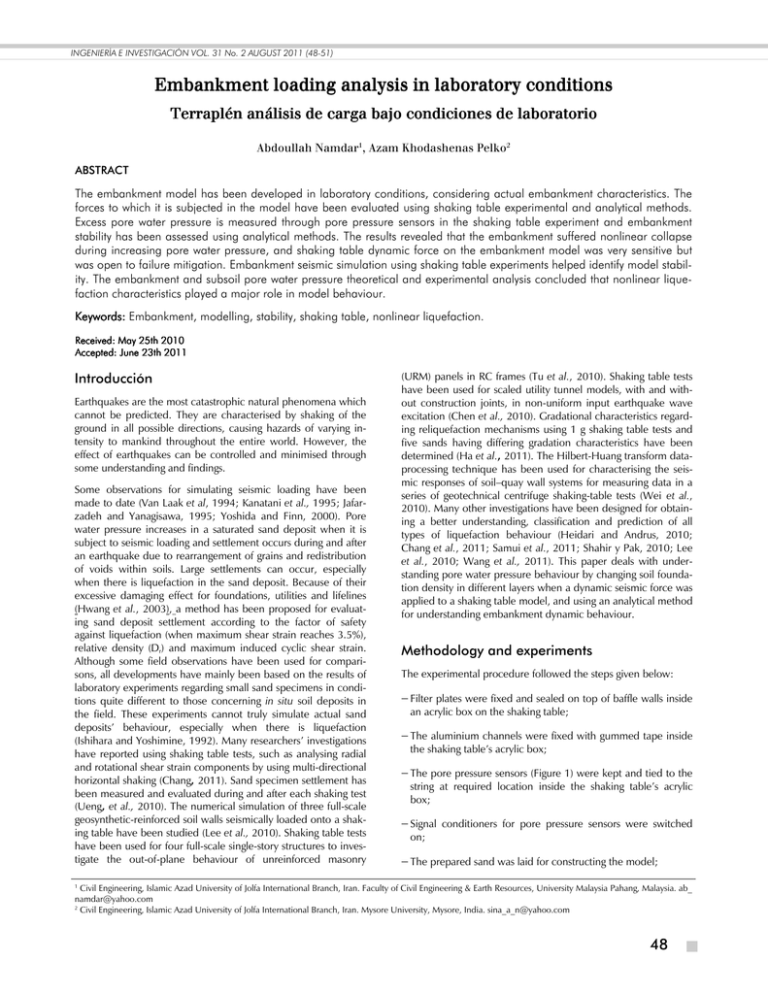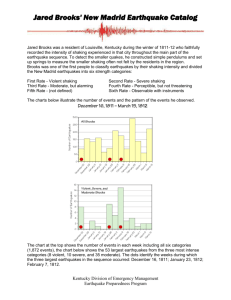English
advertisement

INGENIERÍA E INVESTIGACIÓN VOL. 31 No. 2 AUGUST 2011 (48-51) Embankment loading analysis in laboratory conditions Terraplén análisis de carga bajo condiciones de laboratorio Abdoullah Namdar1, Azam Khodashenas Pelko2 ABSTRACT The embankment model has been developed in laboratory conditions, considering actual embankment characteristics. The forces to which it is subjected in the model have been evaluated using shaking table experimental and analytical methods. Excess pore water pressure is measured through pore pressure sensors in the shaking table experiment and embankment stability has been assessed using analytical methods. The results revealed that the embankment suffered nonlinear collapse during increasing pore water pressure, and shaking table dynamic force on the embankment model was very sensitive but was open to failure mitigation. Embankment seismic simulation using shaking table experiments helped identify model stability. The embankment and subsoil pore water pressure theoretical and experimental analysis concluded that nonlinear liquefaction characteristics played a major role in model behaviour. Keywords: Embankment, modelling, stability, shaking table, nonlinear liquefaction. Received: May 25th 2010 Accepted: June 23th 2011 Introducción Earthquakes are the most catastrophic natural phenomena which cannot be predicted. They are characterised by shaking of the ground in all possible directions, causing hazards of varying intensity to mankind throughout the entire world. However, the effect of earthquakes can be controlled and minimised through some understanding and findings. Some observations for simulating seismic loading have been made to date (Van Laak et al, 1994; Kanatani et al., 1995; Jafarzadeh and Yanagisawa, 1995; Yoshida and Finn, 2000). Pore water pressure increases in a saturated sand deposit when it is subject to seismic loading and settlement occurs during and after an earthquake due to rearrangement of grains and redistribution of voids within soils. Large settlements can occur, especially when there is liquefaction in the sand deposit. Because of their excessive damaging effect for foundations, utilities and lifelines (Hwang et al., 2003), a method has been proposed for evaluating sand deposit settlement according to the factor of safety against liquefaction (when maximum shear strain reaches 3.5%), relative density (Dr) and maximum induced cyclic shear strain. Although some field observations have been used for comparisons, all developments have mainly been based on the results of laboratory experiments regarding small sand specimens in conditions quite different to those concerning in situ soil deposits in the field. These experiments cannot truly simulate actual sand deposits’ behaviour, especially when there is liquefaction (Ishihara and Yoshimine, 1992). Many researchers’ investigations have reported using shaking table tests, such as analysing radial and rotational shear strain components by using multi-directional horizontal shaking (Chang, 2011). Sand specimen settlement has been measured and evaluated during and after each shaking test (Ueng, et al., 2010). The numerical simulation of three full-scale geosynthetic-reinforced soil walls seismically loaded onto a shaking table have been studied (Lee et al., 2010). Shaking table tests have been used for four full-scale single-story structures to investigate the out-of-plane behaviour of unreinforced masonry (URM) panels in RC frames (Tu et al., 2010). Shaking table tests have been used for scaled utility tunnel models, with and without construction joints, in non-uniform input earthquake wave excitation (Chen et al., 2010). Gradational characteristics regarding reliquefaction mechanisms using 1 g shaking table tests and five sands having differing gradation characteristics have been determined (Ha et al., 2011). The Hilbert-Huang transform dataprocessing technique has been used for characterising the seismic responses of soil–quay wall systems for measuring data in a series of geotechnical centrifuge shaking-table tests (Wei et al., 2010). Many other investigations have been designed for obtaining a better understanding, classification and prediction of all types of liquefaction behaviour (Heidari and Andrus, 2010; Chang et al., 2011; Samui et al., 2011; Shahir y Pak, 2010; Lee et al., 2010; Wang et al., 2011). This paper deals with understanding pore water pressure behaviour by changing soil foundation density in different layers when a dynamic seismic force was applied to a shaking table model, and using an analytical method for understanding embankment dynamic behaviour. Methodology and experiments The experimental procedure followed the steps given below: − Filter plates were fixed and sealed on top of baffle walls inside an acrylic box on the shaking table; − The aluminium channels were fixed with gummed tape inside the shaking table’s acrylic box; − The pore pressure sensors (Figure 1) were kept and tied to the string at required location inside the shaking table’s acrylic box; − Signal conditioners for pore pressure sensors were switched on; − The prepared sand was laid for constructing the model; 1 Civil Engineering, Islamic Azad University of Jolfa International Branch, Iran. Faculty of Civil Engineering & Earth Resources, University Malaysia Pahang, Malaysia. ab_ namdar@yahoo.com 2 Civil Engineering, Islamic Azad University of Jolfa International Branch, Iran. Mysore University, Mysore, India. sina_a_n@yahoo.com 48 NAMDAR , KHODASHENAS PELKO − Coloured sand was laid horizontally and vertically every 10 cm; − Water was slowly allowed through baffle walls for saturating the model; − Pore pressure sensor readings were set to zero in the corresponding signal conditioner to ascertain excess pore water pressure generated during shaking; − Shaking was carried out uniformly for a specified duration (~ 12 seconds); and − The results recorded in a computer were saved soon after completion of the experiment (Namdar, 2009). Results and discussion Shaking table experimental and analytical methods have been used in this practical and theoretical research work for embankment model stability analysis. Tables 1-2 and Figures 4-6 give the shaking table test results and analytical calculation results are given in Table 3. The shaking table dynamic force quickly collapsed the system; it was difficult to clearly observe slope failure shape. The pore pressure sensors helped to recognise nonlinear liquefaction. Table 1. Characteristics of shaking table embankment model Embankment Subsoil Quantity of water used for saturation Duration of saturation Duration of shaking Duration of data collection Maximum displacement recorded during shaking After complete saturation Water level After shaking Embankment Before saturation Subsoil Average model density Embankment After saturation Subsoil Weight of dry sand 0.65 3.19 88 190 12 60 16 304 340 12.01 12.44 12.6 13.8 kN kN Litres Minutes Seconds Seconds mm mm mm kN/m3 kN/m3 kN/m3 kN/m3 Figure 1. Pore pressure sensor. The analytical methods used for calculating safety factor involved three methods: Bishop, ordinary and Janbu in constant mass and volume (Table 3). These results indicated that minimum and maximum safety factors appeared in ordinary and Bishop methods, respectively. Table. 2. Detail of pore pressure characteristics during shaking table test Features Maximum pore water pressure (kPa) Minimum pore water pressure (kPa Average pore water pressure (kPa) P1 1.0 0.0 0.5 P2 3.25 1.95 2.60 P3 2.7 1.3 1.5 P4 3.95 1.45 2.70 Table. 3. Analytical result of slopes Figure 2. Schematic diagram of shaking table with model embankment 10 SI No. 1 2 3 1.5 1 10 Level of Water P2 P4 10 80 60 Factor of Safety 1.396 1.018 1.127 Total volume (M3) 344.74 344.74 344.74 Total Mass (Kg) 4,504.1 4,504.1 4,504.1 Ground Level P3 10 10 5 P1 Method of calculation Bishop Ordinary Janbu 20 PORE PRESSURE SENSOR Figure 3. Position of transducer during the shaking table test (Namdar, 2009) An embankment experimental model was considered and Figure 2 gives a schematic diagram of the shaking table with a model embankment whilst Figure 3 gives a ground level cross-section with sand, water level and pore pressure sensor positions for the embankment model. Figures 4-6 indicate that pore water pressure variation at different parts of the system led to creating nonlinear stress-strain and nonlinear liquefaction. Unit weight in each part of model had to be considered. Figure 6 shows nonlinear liquefied sand approximate tolerance which has direct correlation with the model’s safety and stability factors. The indirect simulation technique clearly indicated that stress-strain, deformation and site stability could be precisely modelled and earth structures could be designed or redesigned based on that for optimising safety factors and maximum stability and minimum project cost. INGENIERÍA E INVESTIGACIÓN VOL. 31 No. 2, AUGUST 2011 (48-51) 49 % of increasing pore water pressure in shaking table test EMBANKMENT LOADING ANALYSIS IN LABORATORY CONDITION ... 4 Conclusion − The behaviour of the embankment model subjected to dynamic force has been studied and theoretical and experimental embankment seismic mitigation and pore water pressure functions evaluated; 3 − The pore water pressure result indicated nonlinear liquefaction governing system stability and the dense layer reducing nonlinear liquefaction and pore water pressure; 2 − The indirect simulation technique clearly indicated that stabil1 1 2 3 4 Pore water pressure sensors No Indirect calculated liquefied sand unit weight Figure 4. Detail of pore pressure characteristics ity and deformation could be precisely modelled and that earthen structures could be designed or redesigned based on that for optimising safety factors and achieving maximum stability and minimum project cost; and − Theoretical and experimental embankment and subsoil pore water pressure analysis concluded that nonlinear liquefaction characteristics play a major role in the model’s behaviour. 13.8 13.6 Acknowledgements 13.4 The first author would like to thank the SJCE Civil Engineering faculty, Mysore, India, for its timely help and guidance. 13.2 Referencias / References 13.0 12.8 1 2 3 4 Pore water pressure sensors No Excess pore water pressure (kPa) Figure 5. Pore water pressure sensors No Vs. indirect calculated liquefied sand unit weight P4 5 4 3 2 1 0 -1 -2 P3 5 4 3 2 1 0 -1 -2 P2 Ha, I-K., Olson, S. M., Seo, M-W., Kim, M-M., Evaluation of reliquefaction resistance using shaking table tests., Soil Dynamics and Earthquake Engineering, 31, (4), 2011, pp. 682691. Heidari, T., Andrus, R. D., Mapping liquefaction potential of aged soil deposits in Mount Pleasant., South Carolina Engineering Geology, 112, (1), 2010, pp. 1-12 Hwang, J.H., Yang, C.W., Chen, C.H., Investigations on soil liquefaction during the Chi-Chi earthquake., Soils Found, 43 (6), 2003, pp. 107–123. Ishihara, K., Yoshimine, M., Evaluation of settlements in sand deposits following liquefaction during earthquakes., Soils Found, 32 (1), 1992, pp. 173–188. P1 4 5 6 7 8 9 10 11 12 13 14 15 16 17 18 19 20 T im e(sec) F ig. 6. T im e h isto ries o f ex cess p ore w ater Figure 6. Time histories of excess pore water pressure of test in shaking table test, ( Namdar, 2009) 50 Chang, W. J., Evaluation of undrained shear strains in multidirectional horizontal shaking., Soil Dynamics and Earthquake Engineering, 31, (7), 2011, pp. 906-920 Chen, J., Shi. X., Li, J., Shaking table test of utility tunnel under non-uniform earthquake wave excitation., Soil Dynamics and Earthquake Engineering 30, (11), 2010, pp. 1400-1416. 5 4 3 2 1 0 -1 -2 5 4 3 2 1 0 -1 -2 Chang, M., Kuo, Ch-P., Shau, Sh-H., Hsu, R-E., Comparison of SPT-N-based analysis methods in evaluation of liquefaction potential during the 1999 Chi-chi earthquake in Taiwan., Computers and Geotechnics, 38, (3), 2011, pp. 393-406. INGENIERÍA E INVESTIGACIÓN VOL. 31 No. 2, AUGUST 2011 (48-51) Jafarzadeh, F., Yanagisawa, E., Settlement of sand models under unidirectional shaking., In: Proceedings of the first international conference on earthquake and geotechnical engineering, IS-Tokyo’95, ( 2), 1995, pp. 693–8. Kanatani, M., Nishi, K., Touma, J., Large shake table tests of saturated sand layer and numerical simulations by nonlinear analysis method., In: Proceedings of the first international conference on earthquake and geotechnical engineering, ISTokyo’95,(2), 1995, pp. 705–10. NAMDAR , KHODASHENAS PELKO Lee, K.Z.Z., Chang, N.Y., Ko, H.Y., Numerical simulation of geosynthetic-reinforced soil walls under seismic shaking., Geotextiles and Geomembranes, 28, (4), 2010, pp. 317334. Lee, Y-F., Chi, Y-Y., Juang, C. H., Lee, D-H., Annual probability and return period of soil liquefaction in Yuanlin., Taiwan attributed to Chelungpu Fault and Changhua Fault Engineering Geology, 114, (3-4), 2010, pp. 343-353. Namdar A., Seismic Evaluation of Sandy Embankment Model., Bulletin of the Polytechnic Institute of Jassy, Universitatea Tehnică, Gheorghe Asachi, din Iaşi, Tomul LV (LIX), Fasc. 3, 2005, pp. 39-52. Samui, P., Kim, D., Sitharam, T.G., Support vector machine for evaluating seismic-liquefaction potential using shear wave velocity., Journal of Applied Geophysics, 73, (1), 2011, pp. 8-15. 3935 . Ueng, T.S., Wu, C.W., Cheng, H.W., Chen, C.H., Settlements of saturated clean sand deposits in shaking table tests., Soil Dynamics and Earthquake Engineering, 30, (2), 2010, pp. 50-60. Van Laak, P.A., Taboada, V.M., Dobry, R., Elgamal, A.W., Earthquake centrifuge modeling using a laminar box., In: R.J. Ebelhar, V.P. Drnevich and B.L. Kutter, Editors, Dynamic geotechnical testing II, ASTM STP 1213, ASTM International, 1994, pp. 370–384. Wei,, Y-Ch., Lee , Ch-J., Hung, W-Y., Chen,, H-T., Application of Hilbert-Huang transform to characterize soil liquefaction and quay wall seismic responses modeled in centrifuge shakingtable tests., Soil Dynamics and Earthquake Engineering, 30, (7), 2010, pp. 614-629. Shahir, H., Pak, A., Estimating liquefaction-induced settlement of shallow foundations by numerical approach., Computers and Geotechnics, 37, (3), 2010, pp. 267-279. Wang, Z., Lu, Y., Bai, Ch., Numerical simulation of explosioninduced soil liquefaction and its effect on surface structures., Finite Elements in Analysis and Design, 47, (9), 2011, pp. 1079-1090. Tu, Y-H., Chuang, T-H., Liu, P-M., Yang, Y-S., Out-of-plane shaking table tests on unreinforced masonry panels in RC frames., Engineering Structures, 32, (12), 2010, pp 3925- Yoshida, N., Finn, W.D.L., Simulation of liquefaction beneath an impermeable surface layer., Soil Dyn Earthquake Eng., 19 2000, pp. 333–338. INGENIERÍA E INVESTIGACIÓN VOL. 31 No. 2, AUGUST 2011 (48-51) 51




